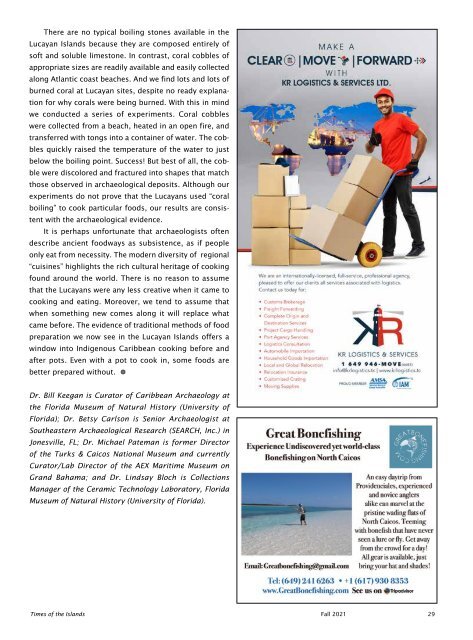Times of the Islands Fall 2021
Presents the "soul of the Turks & Caicos Islands" with in-depth features about local people, culture, history, environment, real estate, businesses, resorts, restaurants and activities.
Presents the "soul of the Turks & Caicos Islands" with in-depth features about local people, culture, history, environment, real estate, businesses, resorts, restaurants and activities.
Create successful ePaper yourself
Turn your PDF publications into a flip-book with our unique Google optimized e-Paper software.
There are no typical boiling stones available in <strong>the</strong><br />
Lucayan <strong>Islands</strong> because <strong>the</strong>y are composed entirely <strong>of</strong><br />
s<strong>of</strong>t and soluble limestone. In contrast, coral cobbles <strong>of</strong><br />
appropriate sizes are readily available and easily collected<br />
along Atlantic coast beaches. And we find lots and lots <strong>of</strong><br />
burned coral at Lucayan sites, despite no ready explanation<br />
for why corals were being burned. With this in mind<br />
we conducted a series <strong>of</strong> experiments. Coral cobbles<br />
were collected from a beach, heated in an open fire, and<br />
transferred with tongs into a container <strong>of</strong> water. The cobbles<br />
quickly raised <strong>the</strong> temperature <strong>of</strong> <strong>the</strong> water to just<br />
below <strong>the</strong> boiling point. Success! But best <strong>of</strong> all, <strong>the</strong> cobble<br />
were discolored and fractured into shapes that match<br />
those observed in archaeological deposits. Although our<br />
experiments do not prove that <strong>the</strong> Lucayans used “coral<br />
boiling” to cook particular foods, our results are consistent<br />
with <strong>the</strong> archaeological evidence.<br />
It is perhaps unfortunate that archaeologists <strong>of</strong>ten<br />
describe ancient foodways as subsistence, as if people<br />
only eat from necessity. The modern diversity <strong>of</strong> regional<br />
“cuisines” highlights <strong>the</strong> rich cultural heritage <strong>of</strong> cooking<br />
found around <strong>the</strong> world. There is no reason to assume<br />
that <strong>the</strong> Lucayans were any less creative when it came to<br />
cooking and eating. Moreover, we tend to assume that<br />
when something new comes along it will replace what<br />
came before. The evidence <strong>of</strong> traditional methods <strong>of</strong> food<br />
preparation we now see in <strong>the</strong> Lucayan <strong>Islands</strong> <strong>of</strong>fers a<br />
window into Indigenous Caribbean cooking before and<br />
after pots. Even with a pot to cook in, some foods are<br />
better prepared without. a<br />
Dr. Bill Keegan is Curator <strong>of</strong> Caribbean Archaeology at<br />
<strong>the</strong> Florida Museum <strong>of</strong> Natural History (University <strong>of</strong><br />
Florida); Dr. Betsy Carlson is Senior Archaeologist at<br />
Sou<strong>the</strong>astern Archaeological Research (SEARCH, Inc.) in<br />
Jonesville, FL; Dr. Michael Pateman is former Director<br />
<strong>of</strong> <strong>the</strong> Turks & Caicos National Museum and currently<br />
Curator/Lab Director <strong>of</strong> <strong>the</strong> AEX Maritime Museum on<br />
Grand Bahama; and Dr. Lindsay Bloch is Collections<br />
Manager <strong>of</strong> <strong>the</strong> Ceramic Technology Laboratory, Florida<br />
Museum <strong>of</strong> Natural History (University <strong>of</strong> Florida).<br />
<strong>Times</strong> <strong>of</strong> <strong>the</strong> <strong>Islands</strong> <strong>Fall</strong> <strong>2021</strong> 29

















